Fantail pigeons, also known as peacock pigeons, masakali, laka, and lakha kabootar are globally the most liked fancy pigeon breed. The name Fantail comes from their magnificent fan-shaped tail.
Fantail pigeons walk on their toes with their chest carried upright, touching their tail, and their neck shaking. Fantails have beautiful muffs and foot feathers. Interestingly, they have a low mortality rate despite their delicate look.
They like to stay in one place all their life and they barely fly at heights like regular pigeons. Fantails are easy to raise and breed.
Originally, there are only two types of fantail pigeons, the Indian Fantails and the Garden Fantails. However, more fantail mutations have been introduced over the last few decades.
Currently, there are seven known types of fantail pigeons.
- Indian Fantail
- American Fantail
- English Fantail
- Garden Fantail
- Silky Fantails
- Singapore Fantail
- Thai Fantail
Their names are associated with the country of their origin. Whereas the silky fantails got their name from the rare silky touch on their feathers.
| Fantail Type | Indian Fantail | American Fantail | English Fantail | Garden Fantail | Silky Fantail | Thai Fantail | Singapore Fantail |
|---|---|---|---|---|---|---|---|
| Origin | India & Pakistan | USA & Pakistan | UK | India | India & Pakistan | Thailand & India | Singapore, India & Pakistan |
| Tail Feathers | 28-35 | 30-45 | 30-45 | 20-30 | 28-35 | 22-25 | 30-45 |
| Foot-feathers (in) | 2-3 | 2-4 | None | None | None | 1-2 | 2-4 |
| Crest | Peak | Peak/Shell | None | None | None | Peak Crest or None | Peak |
| Length (in) | 10.2-11.8 | 12-15 | 9.5-11 | 9.5-11 | 9.5-11 | 9.8-11 | 10.2-11.8 |
| Weight (g) | 350-450 | 450-600 | 300-400 | 250-350 | 250-350 | 300-400 | 400-500 |
| Colors | 10+ | 10+ | 10+ | 10+ | 2 | 4+ | 10+ |
| Flight | Average | Low | Average | Good | Low | Average | Average |
| Life Span (years) | 10-15 | 10-15 | 10-15 | 10-15 | 7-10 | 10-15 | 10-15 |
| Mortality Rate | Low | Average | Low | 10-15 | High | Low | Low |
| Pair Price (USD) | $70-120 | $200-300 | $150-200 | $20-30 | $70-120 | $20-30 | $70-120 |
Indian Fantail Pigeon
Indian Fantails are the most common type of fancy pigeons all over the World. They originated in the Subcontinent (Pakistan and India). Like other fantail types, Indian Fantails have heavy fan-shaped tail and foot feathers unlike some.
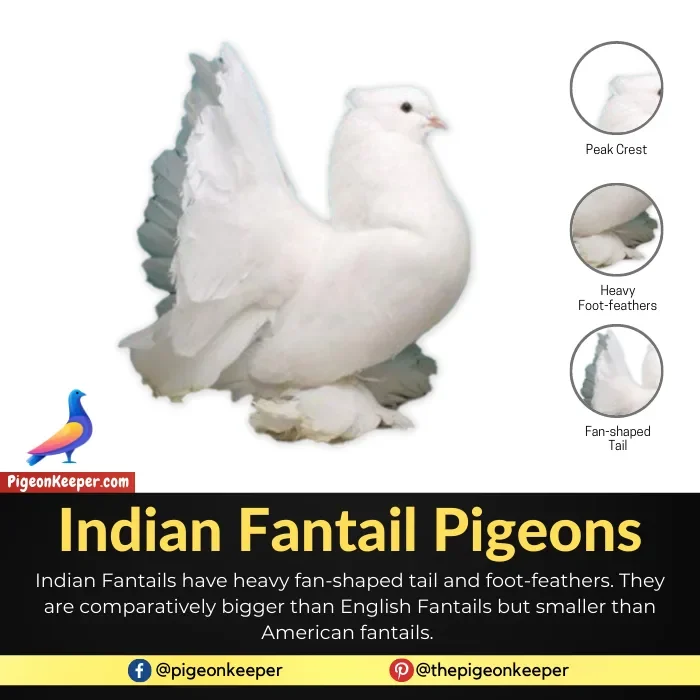
They are comparatively bigger than English Fantails but smaller than American fantails. However, they have as good foot-feathers as American Fantails.
American Fantail Pigeon
American Fantails look like a giant version of Indian fantails. They have all the traits of Indian Fantails except they are bigger in size, have a heavier tail, and have a bit of aggression on the face.
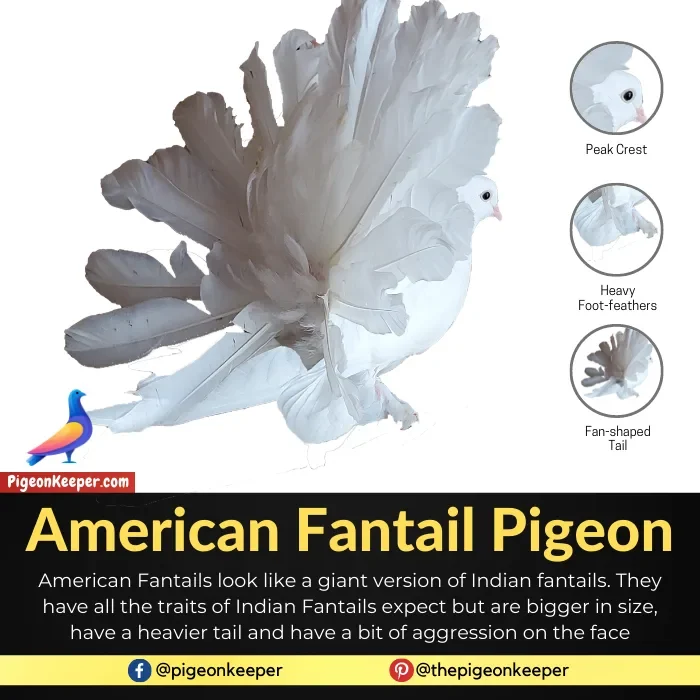
Since in USA and UK, the English Fantails are recognized as American Fantails, many breeders consider these birds as Indian Fantails that have large tails and muffs.
English Fantail Pigeon
English fantails were traditionally smaller than Indian fantails but the modern bloodline is almost equal in size. Their tail is heavier as compared to Indian fantails. Their head is always pulled-back and touches their tail and their neck shakes. They do not have foot feathers or crest,
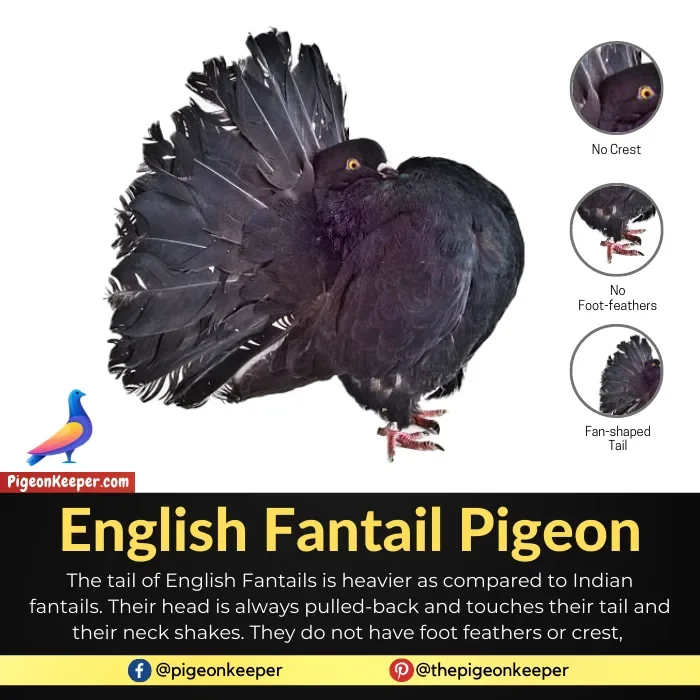
Garden Fantail Pigeon
Garden Fantail is one of the oldest Fantail pigeon types that has existed for several centuries. Over the past few centuries, many fanciers have worked on this breed and as a result, they developed English Fantail. Both breeds look alike except English Fantails have a larger body and tail structure and their tail is comparatively flat.

Garden fantails were among the few pigeon breeds that Charles Darwin kept in his garden to study the evolution process, and this is why English Fantails were once called Garden Fantails.
Thai Fantail Pigeon
Thai fantails have a strong resemblance to Indian fantails and they are hard to distinguish. Some fanciers claim that Thai fantail pigeons are actually a result of cross-breeding between Indian fantails and ordinary pigeons.
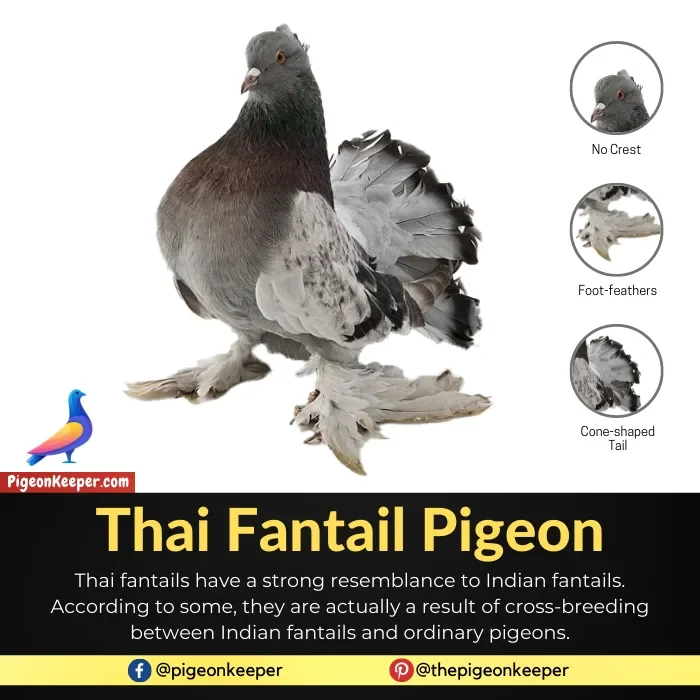
It is also believed that centuries ago, Indian fantails were brought to Thailand and their physical structure changed over time. Interestingly, in Thailand, Thai fantails are available in only white and black color, other colors are rare.
Difference Between Thai Fantails and Indian Fantails
There are very few differences between Thai fantails and Indian fantails. Thai fantail pigeons are smaller and low-weighted as compared to Indian fantail pigeons. Although they look similar, Indian fantails have a wide tail span, consisting of 28-35 feathers whereas Thai fantails have a bit cone-shaped tail containing 22-25 feathers.
The cross-breed between Thai fantails and Indian fantails have nearly 30 feathers in their tail and their tail resembles a typical Thai fantail’s shape.
Singapore Fantail Pigeon
Just as Thai fantail pigeons, Singapore pigeons also have a strong resemblance to Indian fantail pigeons. But Singapore fantails have a superior tail and body structure.
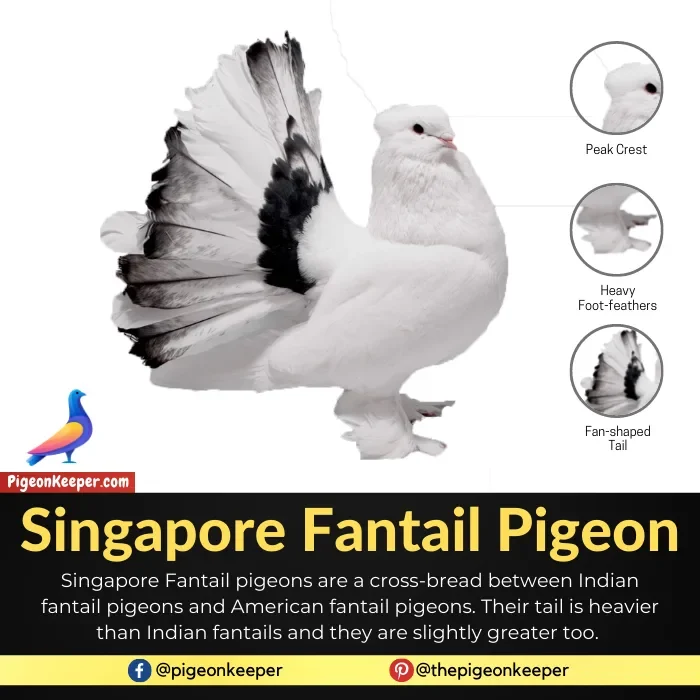
They were developed in the late 20th century. Their origin is unknown but most fanciers believe that they originated in Singapore.
The truth is. Singapore Fantail pigeons are a cross-bread between Indian fantail pigeons and American fantail pigeons. Their tail is heavier than Indian fantails and they are slightly greater too. They were developed in Pakistan and hence they are available only in Pakistan. This breed never originated or existed in Singapore.
Silky Fantail Pigeons
Silky fantails, also known as Lace Fantails, are the same as other types except their feathers are soft, shiny and laced. They carry silky effects in their genetics. Unfortunately, their feathers are so fragile that they cannot fly properly and rarely survive for long. Silky fantails are quite rare and sensitive.
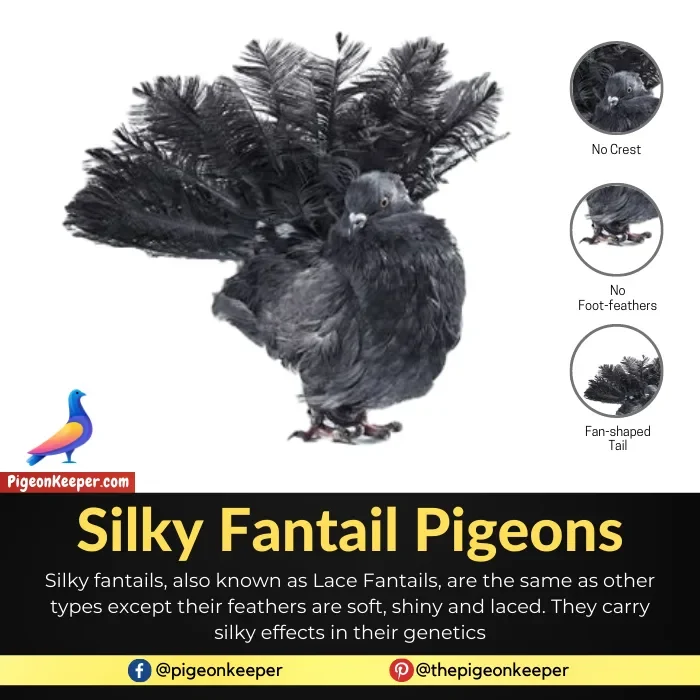
Breeding a Silky fantail pigeon pair is discouraged. The breeding between two Silky fantails pigeons usually produces unhealthy chicks with a high mortality rate. Fanciers prefer breeding Silky Fantails with regular Fantails to produce more Silky Fantails.
Fantail Pigeon History
The recorded history of fantail pigeons starts from the 12th century. The earliest known fantail pigeon types are Indian and Garden. Some historians state that the breed originated in Spain whereas some claim it originated in the subcontinent (today known as Pakistan and India). However, fantails always have been more common in the subcontinent than in any country around the globe.
Most of the fantail pigeon colors we see today didn’t exist in the earliest generations. These colors were developed over decades of selective breeding. Fantails of different colors were crossbred with other breeds to produce new colors.
Mughal Emperors Loved Fantails
For centuries, fantails beautified castles and fascinated emperors. It is said that many Mughal Emperors kept fantail pigeons. Especially, the 16th-century emperor Akbar adored their beauty and tumbling flight. Akbar had thousands of fantail pigeons and several caretakers to ensure his pigeons were properly cared for. Akbar was so obsessed with his pigeons that he took them with him whenever he traveled.
Fantails are Descendants of Rock Dove
During the mid-19th century, fantails remained at the center of Charles Darwin’s research on the origin of species. Charles Darwin believed they are descendants of Rock dove and recent studies show he was right.
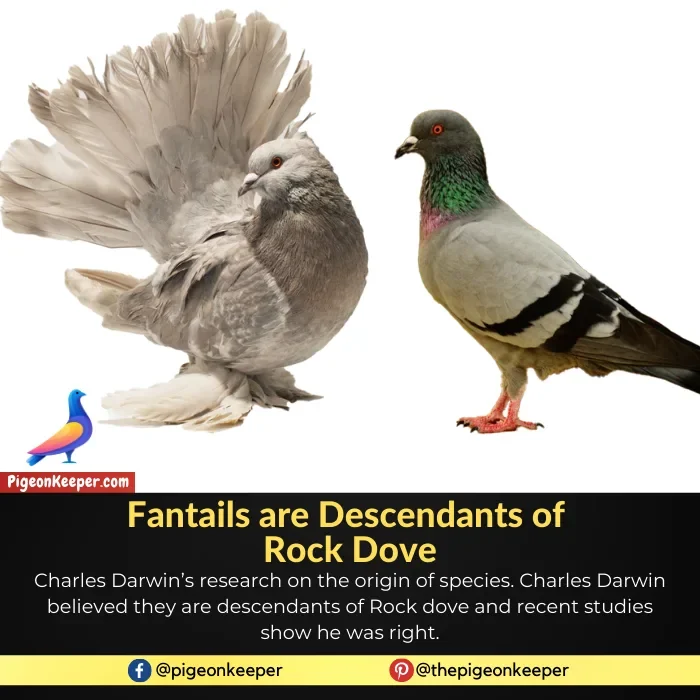
20th Century Fantails in India
A 1918 American research study on “the inheritance of tail feathers in fantail pigeons” mentions fantails having 33 and 34 tail feathers in Madras and Calcutta region. The same study also mentions fantails in America had 12-20 tail feathers in the same era.
This explains why the India and Pakistan region always had fantails with 30+ tail feathers. It also supports the claim that this region is the true origin of Fantail pigeons.
Fantail Pigeon Breeding and Laying Habits
Fantail pigeons are fast breeders, they can produce a huge flock within a few years. They are easy to breed and they take great care of their babies.
Breeding Age
Fantails pigeons start breeding at the age of 6 months and breed for almost 8-10 years.
Breeding Season
They do not have any specific breeding seasons; they breed all year. However, they breed more often in summers as the warm weather is favorable for breeding and their babies to grow. Typically Fantails breed 4-6 times a year. But at old age, they breed 2-3 times a year.
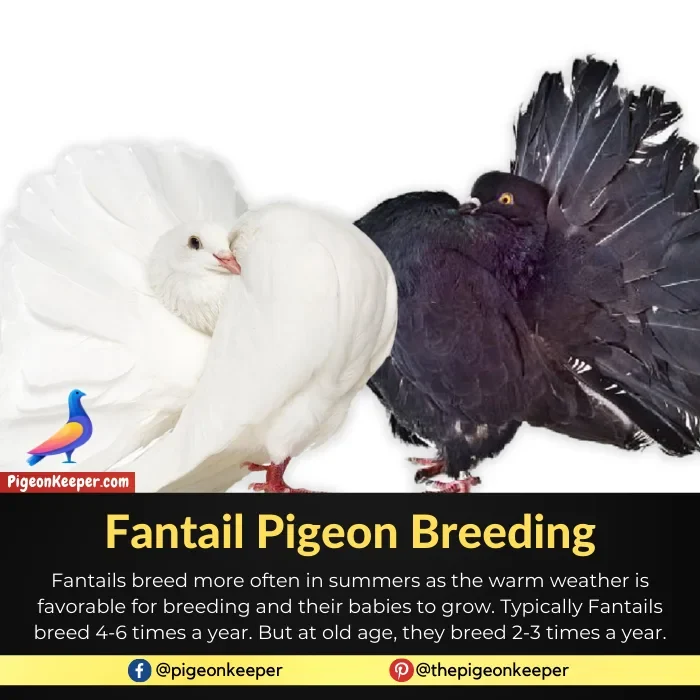
Breeding Signs
When the pigeon pair is near to breed, it regularly baths and cleans its feathers. Generally, the pair keeps a distance from other pigeons and mates 2-6 times a day. The pair spends time in the nest; cleaning and renovating it. The female lays the first egg after 10 days of mating.
Eggs
Fantail pigeons lay two eggs that hatch after 16 days of incubation. They start incubation after laying 2nd egg. Since Fantails are excellent caretakers, almost 75% of the time, both eggs hatch. Usually, one of the chicks is a male and the other is a female.
Parenting
Fantail pigeons are excellent parents, they raise chicks until they can eat on their own and then gradually stop feeding them.
Fantail Pigeon Mating Problems
Fantail pigeons frequently mate like other pigeons but if they have very large tails, they often end up mating without proper fertilization. This happens because the tail of female covers its vent and the male’s vent cannot make contact with the female’s vent. To avoid this problem, expert breeders recommend cutting the tail of both birds
Male and Female Identification in Fantail Pigeons
Young fantails are hard to identify as male or female but adult fantails are easier to identify. Below are some of the ways of identifying fantail pigeon gender.
Gap Between Vent Bones
Typically, the gap between the pelvic bones of a male fantail is so small that you can’t fit in your pinky finger. Whereas the gap between a female fantail pigeon is enough to fit in a pinky finger.
Mating Ritual
During the mating ritual, the male fantail drops its tail, hoots, dances, and runs after the female pigeon. The female pigeon drops its wings to the ground and lets the male chase her. When the pair is in the nest, the male hums and the female picks the male’s feathers with her beak.
When the pair is about to mate, the male pigeon and the female pigeon kiss, and the male pigeon feeds the female pigeon. The female pigeon puts her beak inside the male pigeon’s beak and takes the feed. Then, the male jumps on top of the female and mates.
For more details, read this article: How to Identify Pigeon Gender.
How to Take Care of Fantail Pigeons?
Taking care of fantail pigeons is far easier than taking care of other pigeon breeds.
Protect from Predators
Since fantails are not good at flying, they can easily fall prey to on-ground predators like cats. Always keep them in a cage or enclosure.
Keep Them Warm in Winters
Fantails can survive warm temperatures but they can easily get sick in cold temperatures. Cover their cage/room to maintain the temperature during winters.

Provide Water to Bathe
Fantails love to bathe and it is good for their health and delicate feathers. Moreover, it also helps them regulate their temperature in peak summers. Provide them bathing water in a wide bowl.
For more details, read this article: Fancy Pigeon Care and Health Tips.
Frequently Asked Questions About Fantail Pigeons
Can Fantail pigeons fly?
Yes, Fantail pigeons can fly. Though, they cannot fly for long durations or at great heights. This is because their fan-shaped tail makes it difficult to fly. Typically, fantails can fly up to 150 feet in one flight. Learn more here: Can Fantail Pigeons Fly
Are Fantails Doves or Pigeons?
Biologically, Fantails are typical pigeons. However, Fantail Pigeons are also referred to as doves because they originated from Rock Dove pigeons. By “Fantail Dove”, people usually refer to Garden Fantails.
Why Fantails Pigeons are Used as Droppers
Since Fantails pigeons do not fly for long and come back to the ground after a short flight, pigeon racers use them as droppers. Shortly after they take off, they come back to the ground which encourages racing pigeons to come back to the ground.
Why Fantail Pigeons are More Popular Than Other Fancy Pigeons?
Fantail pigeon is an exhibition breed, it is considered ornamental and that is why many pigeon breeders like to raise them and display them at exhibitions. Moreover, they are good pets, and easy to raise and breed.
How much does Fantail pigeon cost?
Generally, a fantail pigeon pair costs $30-50. The cost depends on the fantail type and the region it is being sold in. Fantails are less costly in Pakistan and India but more costly in USA and UK.
What do Fantail pigeons eat?
Fantail pigeon diet consists of a variety of small and medium-sized seeds like
- Sunflower
- Pearl Millet
- Crushed Corn
- Wheat
- Barley
- Safflower
How to keep Fantail Pigeons?
Keep fantail pigeon pair in a medium-sized cage (2x2x2 ft or larger). Provide them mixed seeds and freshwater daily. Keep them warm in winters and provide them water to bathe in summers.
How long do Fantail pigeons live?
The life span of all fantail pigeon types (except Silky Fantails) is 10-15 years. Silky Fantails live for 7-10 years.
Where can I buy Fantail Pigeons?
You can buy fantail pigeons from a local bird store, online classified advertisement websites/Apps, pigeon club websites, and pigeon breeders on YouTube. Learn more here: Where and How to Buy Fancy Pigeons Online.
Are Fantail pigeons good pets?
Yes, Fantail pigeons are good pets, and they can be easily tamed.
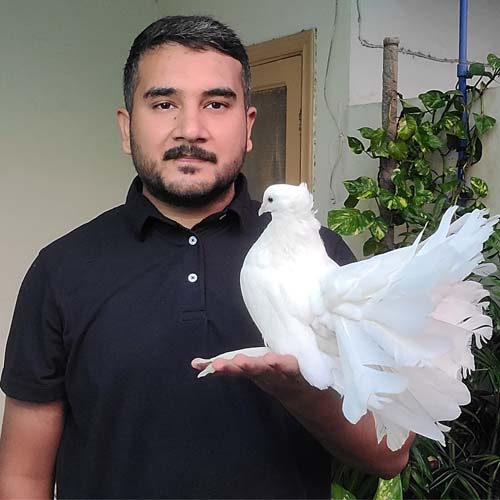
Bilal is a freelance writer and a content creator. He has been in the pigeon hobby for over 15 years. His deep interest in pigeon keeping enabled him to explore the development of various pigeon breeds and share them with the community.

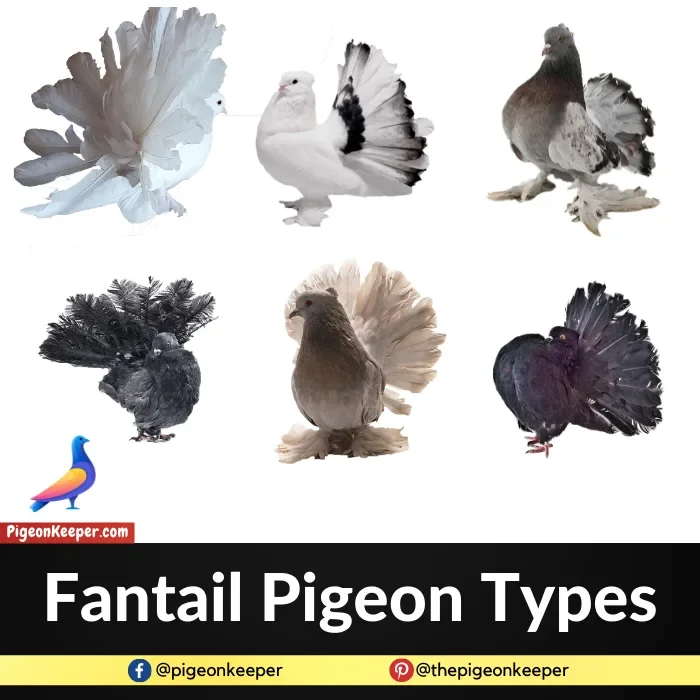


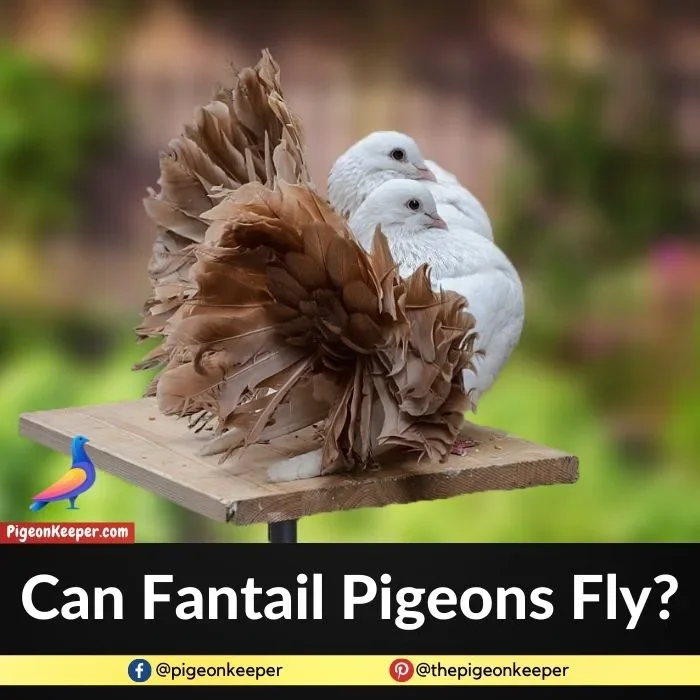
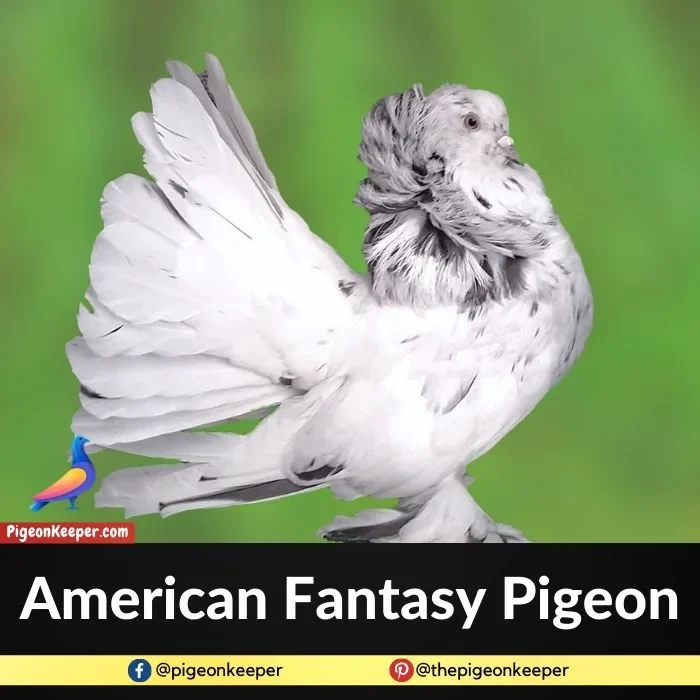
Best info that I found on the Internet about these beautiful birds. So glad I found it as it will help me to care for my own English Fantail. Thank you Bilal
You are welcome Connie 🙂